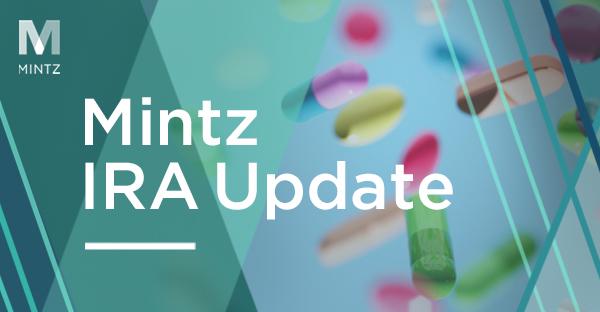Mintz IRA Update — Other Key IRA Programs and Developments: The Medicare Prescription Drug Inflation Rebate Program and Maximum Monthly Cap on Cost-Sharing Payments Program
Although most of the recent focus around the implementation of the Inflation Reduction Act (“IRA”) by the press and industry stakeholders has been on the Medicare Drug Price Negotiation Program, the IRA has several other provisions focused on drug pricing. Two key programs include: (1) the Medicare Prescription Drug Inflation Rebate Program (“Inflation Rebate Program”), and (2) the Maximum Monthly Cap on Cost-Sharing Payments Program (the “Medicare Prescription Payment Plan Program” (previously referred to as the “OOP Smoothing Program”)). This article provides a brief overview of both programs.
Overview of the Inflation Rebate Program:
The central premise of the Inflation Rebate Program is that pharmaceutical manufacturers (“Manufacturers”) must pay rebates to the Medicare Trust Fund if prices for certain Medicare Part B and Medicare Part D drugs increase faster than the rate of inflation.
The Centers for Medicare & Medicaid Services (“CMS”) is responsible for implementing the Inflation Rebate Program, including identifying the drugs subject to the rebates, calculating the rebates, and invoicing the rebates. In early February 2023, CMS released separate guidance for the implementation of the Inflation Rebate Program under Medicare Part D and Medicare Part B.
Medicare Part D Inflation Rebates
As noted above, Manufacturers must pay rebates to the Trust Fund if prices increase faster than inflation. The first 12-month period that CMS will analyze increases in drug prices for Part D drugs will be from October 1, 2022 to October 2023. To determine if a Manufacturer of a Part D drug will be subject to inflation rebates, CMS will analyze how much the drug’s annual manufacturer price for the period exceeds the inflation-adjusted payment amount for the drug. CMS will use 2021 as the base year for inflation-adjusted payment amounts.
Under the IRA provisions, CMS has nine months to invoice Manufacturers; however, for the first two applicable periods that occur beginning October 1, 2022, and October 1, 2023, respectively, CMS may delay invoicing of Part D drug inflation rebates until December 31, 2025.
Medicare Part B Inflation Rebates
The first quarter in which certain Medicare Part B drugs were subject to the Inflation Rebate Program began on January 1, 2023. CMS will calculate the inflation rebate amount for Part B drugs on a quarterly basis, and beneficiaries may experience lower coinsurance for certain drugs where a drug’s price outpaces inflation.
To determine if a Manufacturer is subject to inflation rebates, CMS will look at the amount (if any) by which the “specified amount” exceeds the inflation-adjusted payment amount. The specified amount for single source drugs is 106% the lesser of average sales price ("ASP") or wholesale acquisition cost ("WAC"), and for biosimilars, it is 100% of the ASP for the biosimilar biological product plus 6% of the ASP for the reference biological product. CMS will use the calendar quarter beginning July 1, 2021 as the benchmark quarter (for drugs approved or licensed on or before December 1, 2020).
As of April 1, 2023, individuals with fee-for-service Medicare and Medicare Advantage began potentially seeing Part B coinsurance amounts for certain drugs increase at a slower pace. For certain Part B drugs and biologicals with prices that have increased faster than the rate of inflation, the beneficiary coinsurance is now required to be 20% of the inflation-adjusted payment amount. In Medicare Advantage, whether a member’s cost-share is limited to 20% for drugs subject to inflation rebates can change depending on whether a member receives the drug from an in-network versus out-of-network provider and plan benefit designs. CMS announced it will post payment information each quarter for separately payable Part B drugs, and on September 13, 2023, announced a list of 34 prescription drugs for which Part B beneficiary coinsurances may be lower between October 1 and December 31, 2023. For the fourth quarter of 2023, Medicare beneficiaries may see a decrease in coinsurance amounts by as much as $1 to $618 per average dose.
The HHS Office of the Inspector General (“OIG”) has already issued a technical assistance brief identifying potential administrative challenges CMS may face in implementing the Medicare Inflation Rebates for Part B drugs.
Overview of the Medicare Prescription Payment Plan Program
The Medicare Prescription Payment Plan Program will require Part D plans (“PDPs”) to offer their beneficiaries the option to pay their out-of-pocket (“OOP”) drug costs through monthly payments over the course of the plan year instead of at the pharmacy point of sale beginning January 1, 2025.
In practice, once a beneficiary opts into the Medicare Prescription Payment Plan Program, they will pay $0 at the pharmacy counter for the remainder of the year. The PDP must then send monthly bills to the beneficiary that spread their copayments out over the plan year. CMS provides specific formulas to calculate the monthly costs and multiple examples in its Part One Guidance. For Part D beneficiaries who elect to participate in the program, particularly early in the year, the program essentially redesigns the Part D plan to be effectively a zero-cost-share plan with a higher premium (the Part D premium plus the monthly amount to participate in the program).
The PDP must also reimburse the network pharmacy the beneficiaries’ OOP amount. A key impact of this program is that PDPs are now assuming the risk of beneficiaries’ nonpayment of copayments, with limited repercussions against the beneficiary. If a beneficiary fails to make monthly payments, the PDP can remove them from participation in the program following a two-month grace period and prevent the beneficiary from enrolling in the program for the following year. However, the PDP may not charge late fees or interest, and it may not disenroll the beneficiary from the PDP.
For additional information on the Medicare Prescription Payment Plan Program, please refer to our recent blog post.

